
Class Action
Activity Based Working places significant demands on the AV and IT departments. Gilbert+Tobin’s Head of IT Operations, Mitch Owens, talks us through how the right AV can set AWB up for success.
Text:/ Christopher Holder & Mitch Owens
Activity Based Working: for most office workers the words breathe terror; code for: ‘where the hell did my desk go?’
Bosses love the idea because they want their staff to stop being so darn insular, get out of their cubicle and share their amazing ideas with colleagues.
All this seems a reasonable proposition, especially for creative industries where people turn up to work in skivvies and there’s a half-pipe in reception. But what about traditional industries where you need silence and confidentiality… like, say, a legal firm?
You might be surprised to hear that one Sydney-based commercial law firm has taken the big leap into activity based working (AWB). Gilbert+Tobin has taken the lease on four floors of one of the new Barangaroo office blocks and has completely done away with traditional offices — no one has their own desk and nothing is permanently plugged in except the phones. Admittedly Gilbert+Tobin is a comparative upstart on the Australian legal scene and has always been known for innovative thinking but this is a huge leap into the unknown.
AWB makes some immediate demands on a workplace’s AV. If people can no longer say “please step into my office”, then there has to be an alternative — lots of alternatives.
Huddle spaces have become increasingly popular for ad hoc meetings of a small number of individuals.
With AWB normally comes the directive to “work where you’re most effective”. So video conferencing becomes more important, as do VC rooms for colleagues to discuss and collaborate.
Often AWB workplaces may have a good chunk of their employees off site — at home, in the field, on secondment — so monthly town hall meetings become more important, as do larger spaces in the office to occasionally gather the clans or conduct social gatherings.
In other words AWB is changing plenty and it’s AV’s job to make those changes easy.
We asked Gilbert+Tobin’s head of IT Operations, Mitch Owens, to talk AV Asia Pacific through some of the key challenges and the practicalities of the solutions.
Peace of Mind Technology: www.pomt.com
DRIVING A TOWN HALL
Mitch Owens: The main room [no image available, unfortunately] was designed with a number of configurations in mind but the key one was the partner meeting: where we might have 45 of the firm’s partners participating in a three-way VC (with two other Gilbert+Tobin offices) once a month.
We’ve got a replica of the Crestron control panel on an iPad as an app. It allows the AV guy to control the video on one of these large VCs. There are four PTZ cameras (North, Sound, East, West cameras) and each has four preset positions. So we worked with POMT to create those preset position that best suit a partner meeting. So depending on who’s speaking you just press the camera icon on the iPad and the preset you want and it will zoom to that area of the table and the partners in Melbourne and Perth can see who’s speaking.
POMT has done a brilliant job in integrating all the various technologies — video, loudspeakers, microphone, projection — into the ceiling and keeping the room looking neat and clean.
MEETING OPTIONS
Mitch Owens: A key aspect was for video and audio conferencing to integrate with and leverage our Cisco platform. For the three practice floors, rather than build meeting rooms with identical conferencing functionality, we worked with POMT to create different rooms, fit for purpose. Videoconferencing rooms were set up with either single screen or double screen configurations, with other rooms optimised for presentations. Despite the different room functions, POMT ensured the user experience was simple and consistent throughout.
Part of our job is educating users regarding which is the best room for their purposes.
In many regards, the boardroom with the million-dollar views isn’t the best meeting room. We purposely designed it with one screen [see the image over leaf], which is suitable for VC but not great for collaboration — where you can use a second screen to share a spreadsheet or Powerpoint.
Some of the less glamorous VC/collaboration rooms (without the harbour views) are more suitable and set up for that. Other rooms are more geared to having multiple people speaking simultaneously — with the Shure MX beamforming mics.
In some rooms we’ll use the Cisco SX20 PTZ cameras while in others we have the Cisco SX80 camera that tracks the speaker. This feature will also have pros and cons depending on the meeting’s format.
Crestron touchpanels have made our lives considerably easier. They make the technology invisible. Staff are starting a VC session with a touch of a button. If it’s an important meeting and it needs to be ready and waiting, then we’ve trained up our reception/concierge staff and they’re doing a lot of the room setups for us now.




CRESTRON AIR MEDIA
Mitch Owens: We wanted to make presentations easy and wireless where possible. We’ve decided to go with Crestron’s AirMedia to take care of wireless BYOD presentations. When we first moved into the premises we’d pre-installed the AirMedia app onto everyone’s laptops but hadn’t done any training. But it was encouraging to find staff getting on with using it without any training, wirelessly presenting from their devices without any assistance.
MANAGING & BOOKING SPACES
Mitch Owens: More meeting rooms means more maintenance and more that could go wrong, so you need a solid room management platform. We’ve gone down the Crestron Fusion path. Fusion gives us tools like capacity management, and information around system operability. We’ll be endeavouring to use the information to be more preventative around some of our remediation, as opposed to reactive. Changing a lamp before it dies is clearly better than after it dies in the middle of an important meeting.
Naturally, the meeting rooms can be booked and that’s how we’re encouraging staff. There are a handful of small ad hoc meeting spaces that don’t need to be booked.


BOARDROOM BLITZ
Mitch Owens: The biggest issue we had in our previous boardroom was the audio, mainly around user etiquette and sound quality. So when we were designing the new boardroom and the other VC spaces we were determined to use technology that would solve the user etiquette conundrum.
And here’s the reason for the gooseneck microphones in the boardroom. Previously when we had inset table mics, people would throw paper over them — inadvertently and occasionally intentionally. But when they want to be heard the mic will covered. Naturally they see this as a tech issue rather than an ‘etiquette’ issue. So we wanted technology that would avoid these sorts of scenarios.
Now those same people have to consciously think about confidentiality — such is the improved sound quality — those sotto voce conversations are all being picked up. We used to have regular video conferencing audio complaints, so it’s a real step forward.
Other conferencing spaces will use on-table microphones. We’ve opted for the newer Shure MX multi-element boundary mics. Their beamforming capability means we can set them back from the attendees and they’re less likely to be covered with papers.

VIRTUAL MEETING ROOM
Mitch Owens: VMR (virtual meeting room) and CMR (cloud-based meeting rooms) are now the norm. We’ve done away with our on-premise point-to-point Cisco hardware and moved to using Cisco’s cloud products. That does a couple of things: it minimises the amount of gear I’ve got in my data centre — the set up is simple; and it’s easy to operate without any specialist assistance.
Our VMR is back-ended by Webex which has given us huge amounts of flexibility and our users are thoroughly enjoying the experience. It means that if someone is out and about, or stuck in traffic, they can still load the app and join the room-based VC from an airport lounge or wherever. They never had that capability before.

UNDOCKED WORK ENVIRONMENT
Mitch Owens: When it comes to having the flexibility to roam around the office without interruption to your workflow, wi-fi is key. We’ve got a softphone app as an option, staff can wander around with an earbud and not be tethered to a phone. Every lawyer is catered for in the same way — from a partner to a new grads, it’s all been standardised.
My motto is: Anywhere, anytime. Being able to access our systems wherever you are at whatever time of day it is. The next, third, phase is ‘anything’, which will take some more work. But we have staff that might move between client sites and state offices, and it’s crucial they have access to the technology and the data they’re looking for when and where they want it.
CORPORATE MESSAGING
Mitch Owens: Our digital signage strategy came about almost by accident. We had some surplus screens knocking about and our integrator Peace of Mind Technologies suggested we set up a digital signage network. Which has been a stroke of genius because law firms are notorious for sending out a flood of internal messaging emails to staff.
For example, previously we might send an email with the new café menu while now that can be on the digital signage. We’ll also use the signage to let staff know about upcoming training, client events etc.
As we get increasingly comfortable with it, we’re going to start delivering some API-type features. For example, being a law firm where people work late, we could show train timetables after 8pm or a map of where Uber cars are in the area.
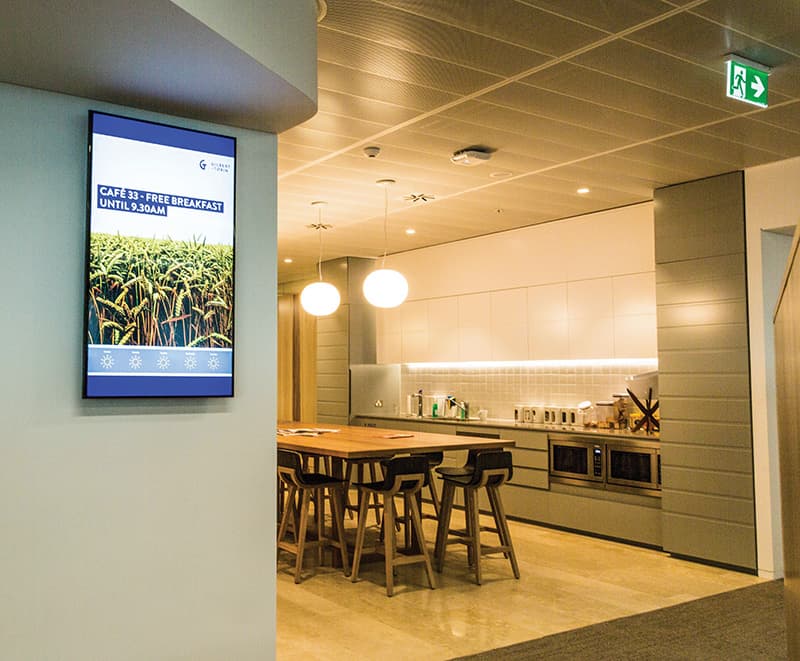






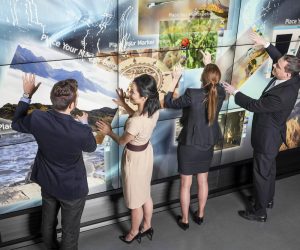


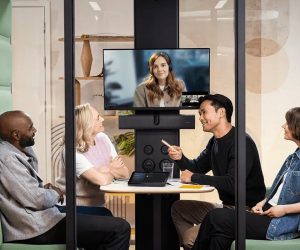

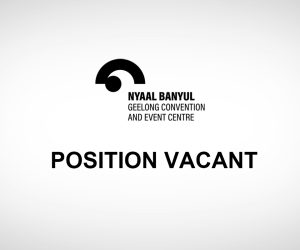
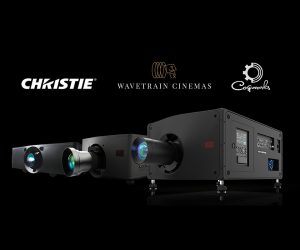


RESPONSES